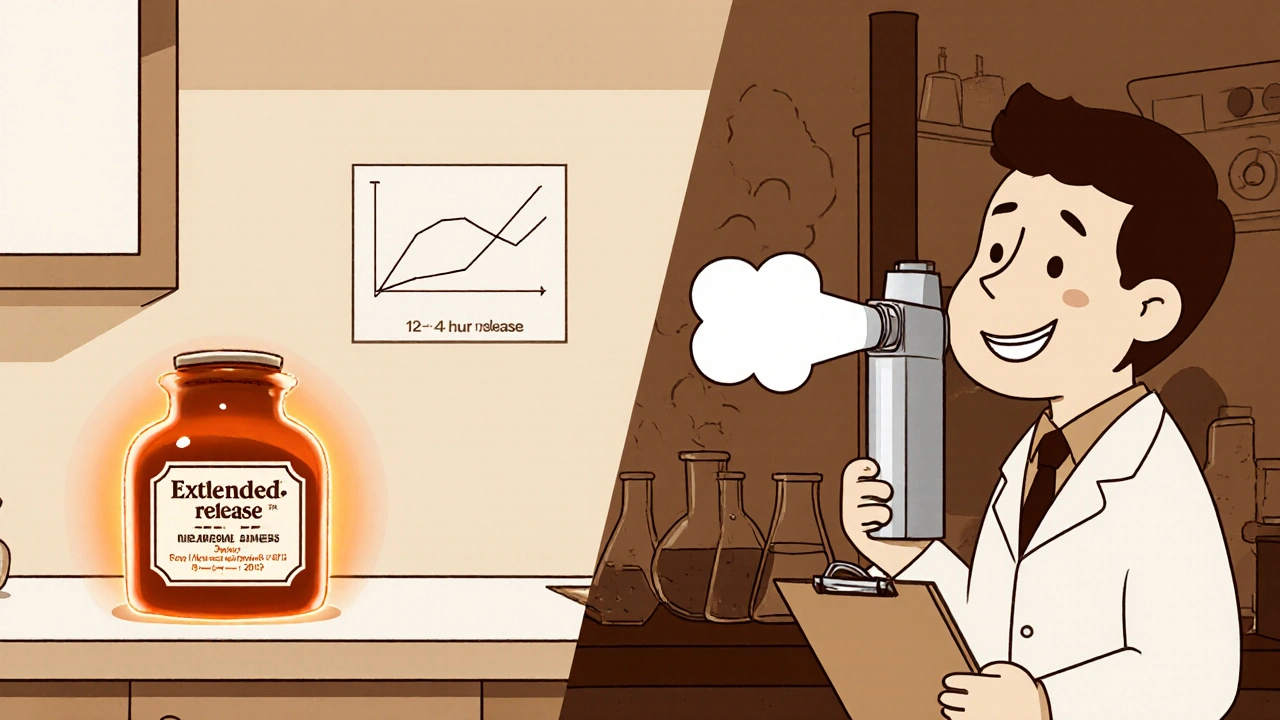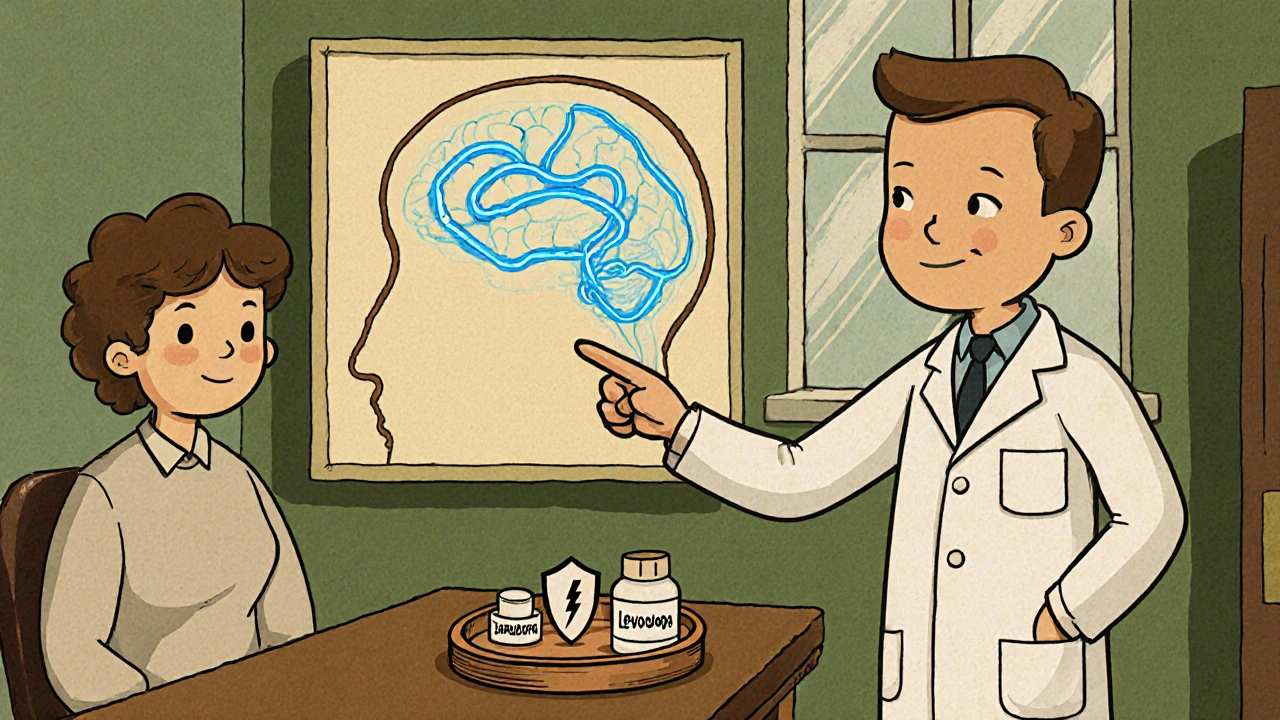Parkinson's Therapy Effectiveness Calculator
Current Symptoms
Treatment Options
When treating Parkinson’s disease, Carbidopa-Levodopa is a combination medication that boosts dopamine levels in the brain while preventing peripheral side effects. It’s been the backbone of therapy for decades, but the field isn’t standing still. Researchers are rolling out new formulations, pairing the drug with other agents, and even exploring gene‑based strategies that could change how we think about symptom control. If you’ve wondered where the next wave of improvements is headed, keep reading - the future is already arriving in clinics and labs.
Why Carbidopa-Levodopa Still Matters
First, a quick refresher. Levodopa crosses the blood‑brain barrier and turns into dopamine, the chemical that motor circuits need to run smoothly. Carbidopa stays in the bloodstream, stopping the conversion of levodopa to dopamine before it reaches the brain, which reduces nausea and allows a lower oral dose. This simple pairing has turned a shaky, short‑acting drug into a reliable daily staple.
But the classic immediate‑release tablets have limits: they wear off after a few hours, leading to “off” periods where symptoms flare. The timing can be unpredictable, especially as the disease progresses. That’s why the newest research focuses on smoothing out those peaks and troughs.
Extended‑Release and Inhaled Options
One of the biggest leaps has been the rollout of extended‑release (ER) formulations. The ER tablet releases levodopa slowly over 12‑14 hours, cutting the number of daily doses from three‑four down to one‑two. Patients report fewer motor fluctuations and a more consistent mood.
For those who need rapid rescue during an “off” episode, an inhaled powder called levodopa‑inhaler (a breath‑activated device delivering levodopa directly to the lungs) has entered the market. Because the lungs absorb the drug faster than the gut, it works in under 10 minutes, bridging the gap until the next oral dose kicks in.
Both ER tablets and inhalers are backed by Phase III trials showing a 30‑40% reduction in daily "off" time compared with standard immediate‑release pills.
Combining Carbidopa‑Levodopa with MAO‑B and COMT Inhibitors
Another trend is the strategic pairing of Carbidopa‑Levodopa with enzymes that break down dopamine. MAO‑B inhibitors (like selegiline or rasagiline) block dopamine breakdown inside the brain, while COMT inhibitors (such as entacapone or the newer opicapone) prevent peripheral conversion. The result: more levodopa stays active for longer, letting patients stick to lower doses.
Recent real‑world studies in Canada and Europe show that adding an MAO‑B inhibitor can shave up to 2 hours off daily "off" periods, while a COMT inhibitor can extend the ON‑time by another hour. The key is personalized titration-start low, watch for dyskinesias, then adjust.

Device‑Assisted Delivery: Pumps and Subcutaneous Options
For patients who still struggle with oral dosing, device‑assisted delivery offers an alternative. The levodopa‑carbidopa intestinal gel (LCIG) pump drops the medication directly into the small intestine via a thin tube, providing a continuous flow that mimics the brain’s natural dopamine supply.
Newer subcutaneous pumps, still in early‑phase trials, deliver levodopa through the skin using a tiny, programmable injector. Early data suggest comparable "on" time to LCIG but with fewer gut‑related side effects.
Both approaches require a multidisciplinary team-neurologists, gastroenterologists, and specialized nurses-to manage implantation, dosing, and troubleshooting.
Gene Therapy and Disease‑Modifying Strategies
While Carbidopa‑Levodopa addresses symptoms, researchers are also hunting for treatments that target the disease root. Gene therapy vectors that deliver enzymes like aromatic L‑amino‑acid decarboxylase (AADC) directly into the brain have entered Phase II/III trials. By boosting the brain’s own capacity to convert levodopa to dopamine, these therapies could amplify the effect of standard medication and reduce the required oral dose.
Another promising avenue is the use of viral vectors to deliver neuroprotective factors such as GDNF (glial cell line‑derived neurotrophic factor). Although still experimental, long‑term follow‑ups hint at slower progression of motor symptoms.
These approaches are still years away from routine use, but they illustrate how the future of Parkinson’s care may blend classic pharmacology with cutting‑edge biology.
Biomarkers and Personalized Dosing
One recurring challenge is that patients respond very differently to the same dose. Emerging biomarkers-like CSF α‑synuclein levels or specific genetic profiles (e.g., SNCA duplication)-are helping clinicians predict who will benefit most from higher levodopa doses versus who might develop dyskinesias sooner.
Digital wearables are also entering the scene. Motion‑tracking smart watches feed real‑time data into algorithms that estimate "on" and "off" periods, allowing more precise dose adjustments. In a 2024 pilot, patients using wearable‑guided dosing cut their daily "off" time by about 25% compared with standard clinic‑based titration.

Key Clinical Trials Shaping the Next Five Years
| Trial | Formulation | Phase | Primary Outcome |
|---|---|---|---|
| LEVO‑PRO | Extended‑release tablet | Phase III | Reduction in daily "off" time ≥30% |
| INHALE‑PD | Inhaled levodopa powder | Phase III | Time to ON < 10min |
| COMBO‑AADC | Gene therapy (AADC) | Phase II/III | Increase in ON‑time without dyskinesia |
| SUB‑LEV | Subcutaneous pump | Phase II | Patient‑reported satisfaction ≥80% |
These studies are recruiting across North America, Europe, and Asia, meaning the data pool is diverse and more likely to reflect real‑world outcomes.
Practical Takeaways for Patients and Clinicians
- Ask your neurologist if an extended‑release tablet fits your routine; fewer daily doses often mean steadier symptom control.
- If you experience sudden "off" episodes, an inhaled rescue dose can bridge the gap while you wait for your next oral pill.
- Consider adding an MAO‑B or COMT inhibitor if "off" time persists despite optimal levodopa dosing.
- For advanced disease, discuss device‑assisted options like LCIG or emerging subcutaneous pumps with your care team.
- Stay informed about clinical trials; participation can give you early access to promising therapies.
Remember, the goal isn’t just more medication-it’s smoother daily living, fewer side effects, and preserving quality of life for as long as possible.
Frequently Asked Questions
What is the main benefit of extended‑release Carbidopa‑Levodopa?
Extended‑release tablets spread levodopa into the bloodstream over 12‑14 hours, which reduces the number of "off" periods and often cuts daily dosing from three‑four pills to one‑two, making the schedule simpler and symptom control steadier.
Can I use an inhaled levodopa dose together with my regular pills?
Yes. The inhaled powder is designed as a rescue medication. It works within minutes and doesn’t interfere with your oral regimen, but you should follow your doctor’s instructions on timing and maximum daily uses.
Are MAO‑B or COMT inhibitors safe to combine with Carbidopa‑Levodopa?
Both drug classes are commonly prescribed alongside Carbidopa‑Levodopa and have a solid safety record. They can increase ON‑time but may also raise the risk of dyskinesias, so dose adjustments and close monitoring are essential.
What should I know about levodopa pumps?
Levodopa pumps deliver a continuous infusion directly to the gut (LCIG) or under the skin (subcutaneous). They can dramatically smooth out motor fluctuations, but require surgical placement, regular maintenance, and a team familiar with the device.
Is gene therapy for Parkinson’s disease available now?
Not yet. Gene‑based approaches are still in Phase II/III trials. They show promise for enhancing levodopa efficacy or providing neuroprotection, but widespread clinical use is projected for the late 2020s.

Amy Aims
Wow, the landscape of Parkinson’s treatment is really shifting under our feet! 😊 The extended‑release tablets are a game‑changer for many who struggle with multiple daily doses. Not only do they smooth out the dopamine peaks, but they also free up morning routines that used to revolve around pill boxes. The inhaled rescue powder feels like science‑fiction, delivering relief in under ten minutes – perfect for those surprise “off” moments. Pairing levodopa with MAO‑B inhibitors adds another layer of stability, kind of like a backup generator for the brain. Real‑world data from Canada and Europe show a two‑hour reduction in “off” time, which is nothing short of amazing. Device‑assisted delivery, especially the intestinal gel pump, brings continuous dosing that mimics natural dopamine release. Subcutaneous pumps may soon give us the same benefits without the gut‑related hassles. Gene‑therapy vectors that boost AADC activity are still early, but the promise of lower oral doses is exciting. Biomarkers like CSF α‑synuclein are starting to guide personalized dosing, turning guesswork into science. Wearable tech that tracks motor fluctuations is already cutting “off” time by a quarter in pilot studies. All of these advances point toward smoother daily lives and fewer side effects. It’s encouraging to see that the old backbone of Carbidopa‑Levodopa is being reinforced rather than replaced. Patients who stay informed can work with their neurologists to tailor the best combo for them. Keep the optimism alive, because each new study brings us a step closer to a brighter future! 🙌
Shaik Basha
Bro, u gotta try the new inhaler – it's like 10 min and boom, you're back in game! I've been using it for a month and the "off" episodes are almost gone, lol. The only thing is you need to keep it handy, otherwise you might miss the puff when you need it. Also, the ER tablets are sweet, less pills = less hassle. Keep sharing your thoughts, man, love the vibes! 🙌
Quinn S.
The aforementioned article contains numerous colloquialisms that undermine its scientific credibility. It is imperative to employ precise terminology when discussing pharmacokinetic mechanisms; for instance, the phrase “works in under 10 minutes” should be expressed as “exhibits a rapid onset of action within ten minutes.” Moreover, the casual omission of dosage specifics is unacceptable in a scholarly discourse. One must also refrain from vague qualifiers such as “pretty good” and instead provide quantifiable data. Failure to adhere to these standards reflects poorly upon both the author and the readership.
Dilip Parmanand
Extended‑release tablets really cut down the dosing frenzy. If you’re still on immediate‑release, consider switching – the payoff is clear.
Sarah Seddon
Oh my goodness, Dilip, you nailed it! 🎨 Imagine the freedom of waking up without a mountain of pills-just one smooth tablet and a day full of possibilities. I’ve seen patients light up when they finally trade the jittery “off” cycles for steady, graceful movement. It’s like swapping a rickety old bicycle for a sleek electric scooter that glides effortlessly. Keep spreading the good word; we all deserve that kind of therapeutic poetry! 🌟
Tatiana Akimova
Stop settling for the “old school” dosing schedule! The subcutaneous pump is a powerhouse that can out‑perform oral regimens, and it’s time we push clinicians to adopt it more aggressively. If you’re not on it yet, demand a referral-your brain deserves that cutting‑edge delivery.
Dan Burbank
While I commend Ms. Tatiana’s fervor, one must temper enthusiasm with a discerning appraisal of the evidentiary base. The subcutaneous infusion, albeit promising, remains ensconced within early‑phase trials that, to date, have enrolled a modest cohort. Consequently, extrapolating its superiority over oral formulations is, at best, speculative. Moreover, the logistical and economic ramifications of device implantation cannot be dismissed with cavalier bravado. A nuanced, hierarchical approach-beginning with optimized oral therapy, followed by rigorously selected candidates for pump therapy-embodies the judicious stewardship of both patient welfare and healthcare resources.
Anna Marie
It is heartening to see such a comprehensive overview of the evolving treatment options. Patients often feel overwhelmed, and clear guidance aids shared decision‑making. By integrating both pharmacologic and device‑based strategies, clinicians can tailor regimens to individual needs, fostering better outcomes.
Abdulraheem yahya
When I reflect on the journey of Parkinson’s therapeutics, I am struck by how far we have come from the days when levodopa was the sole hero of the story. The emergence of extended‑release formulations feels like a natural evolution, smoothing out the peaks and valleys that once dictated patients’ daily routines. In parallel, the inhaled powder represents a bold foray into pulmonary delivery, bypassing the gastrointestinal tract altogether and offering rapid relief during those dreaded “off” windows. Pairing levodopa with MAO‑B or COMT inhibitors adds yet another layer of sophistication, granting clinicians a toolbox to fine‑tune dopamine availability. Device‑assisted delivery, whether via intestinal gel pumps or the newer subcutaneous systems, showcases how engineering can complement pharmacology to emulate the brain’s intrinsic dopamine rhythm. Even the nascent gene‑therapy approaches, which aim to augment the brain’s own enzyme capacity, illuminate a future where we might reduce reliance on external medication altogether. Biomarkers and wearable technology further personalize care, turning vague symptom diaries into data‑driven treatment adjustments. All these innovations converge on a common goal: to grant patients a smoother, more predictable quality of life. It is both inspiring and humbling to witness this multidisciplinary symphony at work, and I encourage anyone affected to stay engaged with their care team and explore emerging options.
Preeti Sharma
While the optimism is palpable, one might argue that the relentless pursuit of incremental tweaks masks a deeper philosophical conundrum: are we merely treating symptoms or confronting the very essence of neurodegeneration? The answer may lie beyond pharmacology, in the realm of identity and meaning.
Ted G
The so‑called “advances” are just pharma’s profit scheme.
Miriam Bresticker
Ever think that dopaminе is just a metaphor for our craving for control? 🤔 If we chase the molecule, maybe we miss the bigger picture of consciousness. 🌌
Claire Willett
ER tablets reduce dosing frequency; inhaled levodopa offers rapid onset; adjuncts like MAO‑B and COMT improve pharmacodynamics.